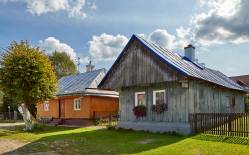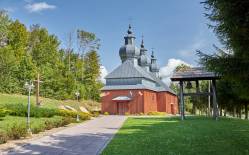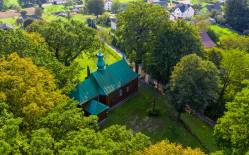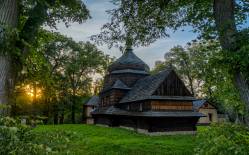If we wanted to choose the most beautiful wooden church in the Przemyśl Foothills it would probably be the tserkva in Piątkowa Ruska. The old village is no longer here. What is left is a small hamlet, and at its outskirts, standing tall amidst trees is the wooden beauty queen, topped with three magnificent Baroque domes.
The Greek Catholic tserkva of St. Dimitrius was built in 1732. This date was carved into the lintel of the main portal. However, historians of wooden architecture tend to believe the building is older, and the latter date corresponds to reconstruction works carried out here. Other restoration works significant for the building took place in 1881.
After the local population was deported from here in the 1940s, the tserkva was abandoned, and fell into ruin. Its interior furnishings were devastated or fell prey to looters.
In 2003, Françoise Nozati, PhD, from Paris, and her husband, established the Association “Bois Debout en Pologne” (Shingles in Poland), which aimed to preserve and promote wooden architecture in south-eastern Poland. Mr. and Mrs. Nozati also supported and promoted icon painters from the Bieszczady mountains. In 2006 the Association collected funds which were used to secure the structural elements of the roof and to replace the rotten ground beam and the logs in the chancel. Renovation works were carried out here again in the recent years.
The three-part log church, oriented towards the East, features three Baroque domes raised on octagonal drums. The protruding eaves along the outer body of the structure are supported on stone pillars. The whole structure is clad with shingles, except for the logs below the eaves.
Inside, on the western side, there is a portal with a shouldered flat arch carrying a Cyrillic inscription: The tserkva is completed Anno Domini 1732. The doors feature decorative fittings. A relic of the original church furnishings, the icon of St. John the Baptist, dated to the late 1600s, was stored at the Castle Museum in Łańcut, and later it was passed on to the Greek-Catholic Archcathedral in Przemyśl.
The old cemetery is next to the church.
Photo: Krystian Kłysewicz
Gallery

Recommended venues on the Trail



This website has been modernized with the financial support of the European Union under the Cross-Border Cooperation Programme Poland-Belarus-Ukraine 2014-2020. The responsibility for its content lies solely with the Podkarpackie Regional Tourism Board and cannot, in any case, be treated as a reflection of the position of the European Union, the Managing Authority, or the Joint Technical Secretariat of the Cross-Border Cooperation Programme Poland-Belarus-Ukraine 2014-2020.













